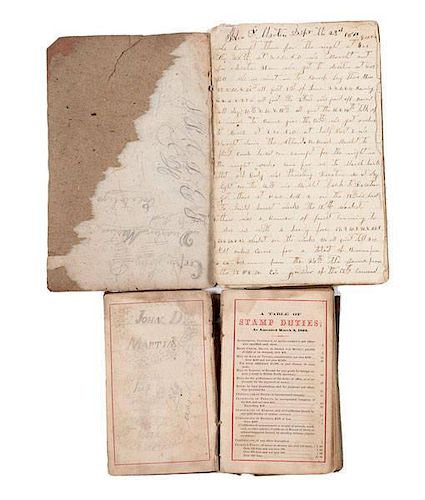Pvt. John D. Martin, 25th Indiana Volunteers, Civil War Diary Plus Journal
About Seller
6270 Este Ave.
Cincinnati , OH 45232
United States
With offices in Cincinnati, Cleveland and Denver, Cowan’s holds over 40 auctions each year, with annual sales exceeding $16M. We reach buyers around the globe, and take pride in our reputation for integrity, customer service and great results. A full-service house, Cowan’s Auctions specializes in Am...Read more
Two ways to bid:
- Leave a max absentee bid and the platform will bid on your behalf up to your maximum bid during the live auction.
- Bid live during the auction and your bids will be submitted real-time to the auctioneer.
Bid Increments
| Price | Bid Increment |
|---|---|
| $0 | $25 |
| $500 | $50 |
| $1,000 | $100 |
| $2,000 | $250 |
| $5,000 | $500 |
| $10,000 | $1,000 |
| $20,000 | $2,500 |
| $50,000 | $5,000 |
| $100,000 | $10,000 |
About Auction
Jun 13, 2014 - Jun 14, 2014
Cowan's Auctions dawnie@cowans.com
- Lot Description
Two Pocket Diaries, 1864.
A typical Civil War soldier from the West, John D. Martin was mustered into the Federal service with the 25th Indiana Infantry at Evansville and in August 1861, during his first months of duty, he witnessed some of the defining battles of the western theatre, including Forts Henry and Donelson, Shiloh, and Corinth. For the next two years, Martin's regiment performed the dirty work of wresting control of northern Mississippi and Alabama and southern Tennessee from Confederate forces before taking part in the Atlanta Campaign (as part of the 16th Army Corps) and Sherman's Marches to the Sea and through the Carolinas (as part of 17th Army Corps).
This two volume collection documents the final, eventful year of Martin's Civil War experience, beginning at the time the 25th Indiana was called to Atlanta and ending in triumph just twelve months later. The first of these volumes is a typical diary of the period covering dates between April 12 and early November, 1864. With three days per page, the entries are characteristically brief and Martin occasionally skips, but he appears not to have been overly respectful of the limitations imposed by the space provided, sometimes stretching a single entry over several "days" when the action before Atlanta reached its peak in the late summer.
The second volume in this collection is the true gem, consisting of a narrative written in the form of a diary -- probably from original notes and diary entries -- and appears to have been written after the end of Martin's service. Martin provides convenient section heads for the action described, such as The Campaign after Hood, The Campaign from Atlanta to Savannah, and South Carolina Campaign. The words John D. Martin 1866, written at the head of two pages, probably indicate when this copy was compiled. Whatever editing Martin may have done is unclear, but the narrative bears all of the detail and immediacy of a piece written at the time, and Martin lost none of his observant skills in recording the valuable detail on the maneuvers of the 25th Indiana, the other units involved, the places visited, and the engagements in which they fought.
Beginning in mid-May 1864, this narrative includes accounts of the regiment's activities in northern Alabama as Sherman was staging for the early phases of the assault on Atlanta. Martin includes a particularly fine description of a relatively little known, but strategically important, engagement at Pond Springs, near Courtland, AL, May 27. The 25th Indiana, he wrote, moved:
slowly along fireing up on their Rear. The Rebs had 600 men & 8 pieces of Art. We drive them 8 m & 9th Ohio Cav. made a charge on them & drove them. We then halted for diner... the Rebs had made a stand at Pon Spring Station. We run up our Batery & Planted 2 guns. The 25th supported it the 17 NY in our Rear the 32 Wis. in there Rear. The cav. Dismounted & took there position on the left. We then opend up on them & exchanged shot with them half an hour. They threw several shell in to our ranks but did no damage. Our guns disabled one of them they then fell back left the Batel field in our Posesion. We followed them it then was getting near sun down. We pursued them to Cortland on the Charleston & Memphis R. Road. We drove them out of the the town...
Since one engagement in Alabama was not enough, Martin includes an account of a second engagement at Pond Springs on June 29, with similarly felicitous results for the Federals: We Marcht in Perfect quietness till just at the Break of day. We heard the Rebs blow Revalee & to sadely imeadietly as they had been warned of our aproach we formed a line and moved up on them as quick as we could. We fired on them and scatered every way some in their drawer tail some on their horse. We captured 10 wagons, 2 Ambulances, 25 Prisoners...
Like most Union regiments during the Atlanta Campaign, the 25th Indiana moved regularly back and forth from the front lines, and Martin's record of the campaign include several rapid accounts of his role in major actions. However, he was ill during the epic Battle of Jonesboro on August 31-Sept. 1, a major engagement for the 25th, and away from the action. The narrative after he returned for the pursuit of Hood in northern Georgia and Alabama (Sept. 29-Nov. 3) is some of his best:
The 1st of October Hood began to move around in our Rear. The army began to fall back on the R. Road... detail on movements to Marietta and Ackworth...the 14th [Oct.] at 10 o.c. AM we got ordered to go out & see where they were. The 25th & a detachment of Cav. We marcht out & found the Rebs Pickits. We captured 1 m & fired on them & returned to Ressaca.... [next day, 25th in advance] we cam on the Rebs. We deploied Co. A & F & B as skirmishers. We moved up on them, & found them in strong force behind works. We fought from 10 o.c. AM till 2 o.c. PM. We made a charge on them & routed them. Our loss was 32 kild & wounded. The Rebs loss was [illeg] at the field of battle as they carried them off. We found some 40 wound a short distance. We captd some few Prisoners...
Once the 25th Indiana was committed to Sherman's campaign to Savannah and through the Carolinas, Martin's account reads more and more like a memoir, brief as it is, though it retains the freshness and detail of a diary:
It was the 15th of Nov. at 9 o.c. AM that we left Atlanta for Savannah. We had cut our own communications off and some 200 m. to March through an unknown land to us inhabited by our Enemy alone. We knew not how strong the Rebs might be but trusting to god & our general (Sherman) who we had followed so often & always came out victorious but be it as it may we Plunged the dark & Dreary Path to strike a heavy blow against the Rebellion all tho we had to strike one of there strong holds on the shores of the great sea. Onward we marcht through swamps & over Rivers through mud & over hills through Rain & through sun shine day & night never halting for an opposing for. Still they cut timbers in our way & Burnt Bridges & Planted torpedoes in our Road but still we prest onward...
A fine survival of a typical western soldier, rough in prose and brutal on spelling, Martin's diary and memoir document the Federal straw that broke the Confederate back. Though no literary titan, Martin was a man who experienced some of the most daring and successful campaigns undertaken during the Civil War, showing an ever-growing confidence in the ability of Union arms.
It has been discovered that two books have been published on these diaries, but we have been unable to locate copies of either. The first book is entitled John D. Martin's Journal: A Union Soldier Boy in the Late War of 1861-1865, published in 1999 by author/editor Darlene McConnell. The background notes state… “From a ‘battered photo copy’ found in the Willard Library (Evansville, Indiana) of the original journal, now lost, kept by John D. Martin of his tour of duty with the 25th Indiana Volunteers Infantry during the American Civil War. Second numbered series of pages is an index compiled by the editor.” The second book is entitled I Must Be Marching Along: Kentuckyana in the War Between the States, published in 2001 and edited by Larry W. Harms. The book is described as being “based on the recollections of a Kentucky ‘Union’ soldier boy in the late war of 1861-1865. The diary was written by Private John D. Martin in the form of a journal as he served in the 25th Indiana Infantry Regiment during the War Between the States. It has chapters on the Ohio River, Shiloh, Davis Mills, General Forrest, W. T. Sherman, Pond Spring and Joe Wheeler, The Atlanta Campaign, and General Hood.”Both volumes show a fair amount of wear, the smaller is stained and the pencil on many pages is very light, though legible with effort, and the pages have tidelines suggesting past water exposure with little other impact. Entries for the months of July and August are written in particularly faint pencil, though legible. The second volume, leather bound, may be missing one or more pages at the beginning, but is otherwise clear and legible throughout.Condition
- Shipping Info
-
SHIPPING. At the request of the buyer, Cowan's will authorize the shipment of purchased items. Shipments usually occur within two weeks after payment has been received. Shipment is generally made via UPS Ground service. Unless buyer gives special instructions, the shipping method shall be at the sole discretion of Cowan's Auctions, Inc.. Cowan's is in no way responsible for the acts or omissions of independent handlers, packers or shippers of purchased items or for any loss, damage or delay from the packing or shipping of any property.
-
- Buyer's Premium



 EUR
EUR CAD
CAD AUD
AUD GBP
GBP MXN
MXN HKD
HKD CNY
CNY MYR
MYR SEK
SEK SGD
SGD CHF
CHF THB
THB





